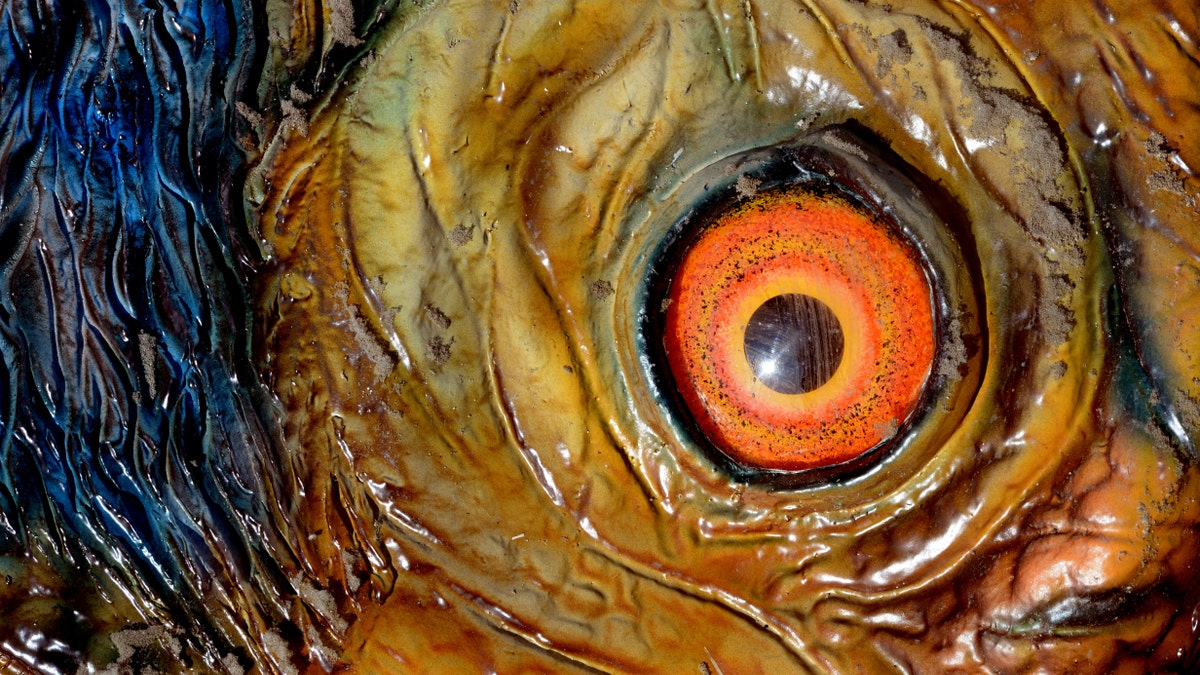
File photo - The eye of a life-sized dinosaur replica is seen in Wustermark, Germany, 23 March 2015. (Photo by Ralf Hirschberger/picture alliance via Getty Images)
A new kind of giant dinosaur has been described in Russia. Dubbed Volgatitan, the herbivore belonged to a family of long-necked dinosaurs called sauropods. It weighed 17 tons and walked the earth 200 million to 65 million years ago.
The enormous dinosaur was identified from seven of its vertebrae, which had been stuck in a cliff for 130 million years until they were discovered on the banks of the Volga river near Ulyanovsk in 1982.
“[The fossils] come from a cliff of marine sediments which are rich in invertebrate fossils such as ammonite and bones [of] marine reptiles,” study author Dr. Alexander Averianov of the Russian Academy of Sciences told Fox News.
180-MILLION-YEAR-OLD 'SEA MONSTER' FOUND WITH SKIN AND BLUBBER
Averianov’s co-author Vladimir Efimov found the first three giant vertebrae after they fell out of the cliff in the early ’80s. A few years later, more limestone from the cliff broke off containing the remaining vertebrae. Efimov published a short note about the discovery in 1997, describing his discovery as “giant vertebrae of unknown taxonomic affiliation.”

An image of the vertebrae. (Alexander Averianov and Vladimir Efimov)
The bones sat for 20 years until they were re-examined by Averianov.
“I started my work on sauropods quite recently, published on sauropod remains from the Late Cretaceous of Uzbekistan and describing the first sauropod taxa from Russia, Tengrisaurus and Sibirotitan, in 2017 and 2018 respectively,” Averianov said. “I decided to also study the fossils reported by Efimov and visited his museum in July 2017 and examined the fossils.”
'UNICORN' FROM THE ICE AGE MAY HAVE EXISTED AT THE SAME TIME AS HUMANS, SHOCKING DISCOVERY REVEALS
Upon inspecting the bones, he noticed the caudal vertebrae’s unusual morphology.
“[After] checking the literature when I returned home, [I] confirmed that this is a new taxon of titanosaurian sauropods,” Averianov recounted. A taxon refers to a specific group.
Titanosaurs were the last surviving group of the giant long-necked dinosaurs and were some of the largest land animals known to have lived. It was previously believed that Titanosaurs’ evolution took place mainly in South America in the Early Cretaceous before some taxa migrated to North America, Europe and Asia in the Late Cretaceous. However, this new discovery in Russia shows that Titanosaurs were more widely distributed in the Early Cretaceous and that some of their important evolutionary stages may have happened in Eastern Europe and Asia.
ENORMOUS 20,000-POUND 'RHINO ELEPHANT’ ROAMED THE TRIASSIC
Weighing in at 17 tons, Volgatitan’s not even close to being the largest titan of the Titanosaurs.
“The largest members of this lineage reached 50-70 tons, but they lived much later, in the Late Cretaceous period,” Averianov explained. “Volgatitan is one of the oldest titanosaurian sauropods which lived in the beginning of the Early Cretaceous period, some 130 million years ago. However, it is quite large comparative to other earliest Cretaceous sauropods.”
Averianov hopes to describe yet another new taxon of another dinosaur next, this one pretty famous as far as iconic dinos go.
“We are currently working on the dinosaurs collected from the Early Cretaceous site in Yakutia, Eastern Siberia,” he said. “The fauna is dominated by stegosaurs and possibly we shall describe a new taxon of stegosaur when all specimens will be prepared.”
The study can be found in the latest issue of Biological Communications.